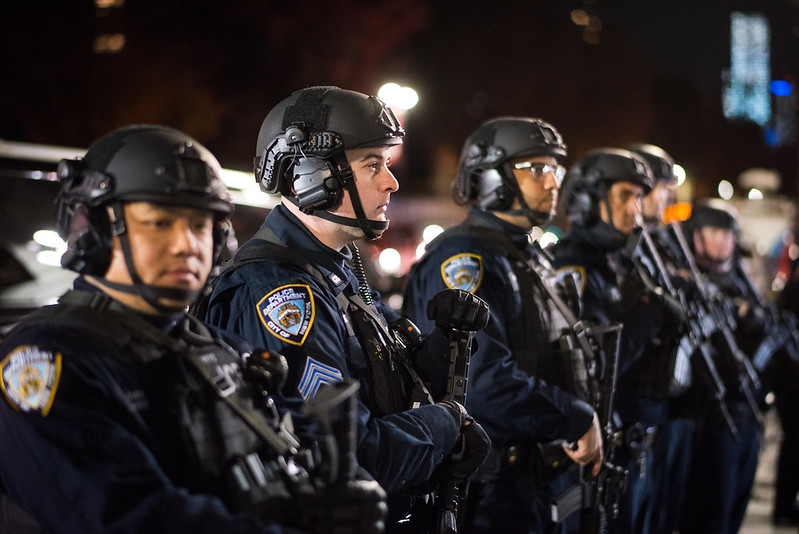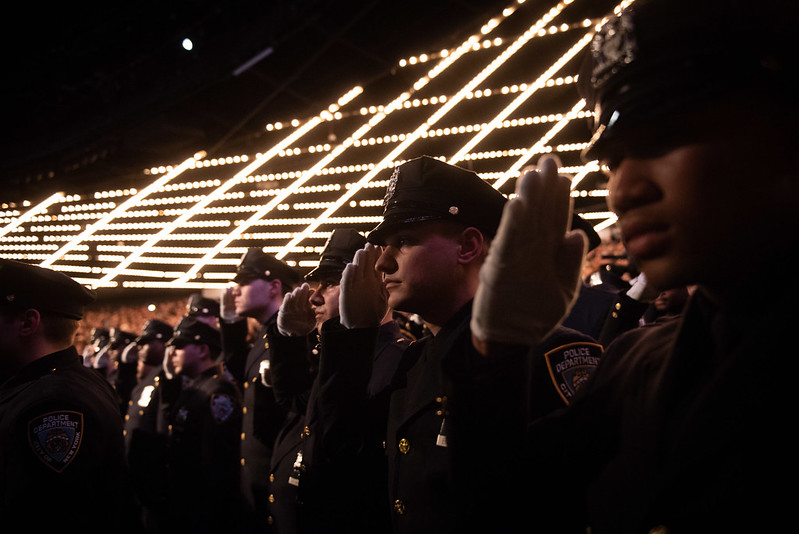Federal Funding Up for NYPD, Down for Human Services

NYPD officers (photo: Edwin J. Torres/Mayor's Office)
Budgets, as the saying goes, reflect our values. Take a closer look at where the money goes – or doesn’t – and you can readily see our nation’s priorities.
This is perhaps never truer than during an economic downturn. At FPWA, we’ve examined the trends in federal spending for human services using our online Federal Funds Tracker. We know that since the Great Recession ten years ago, the federal government’s austere budgets have left human service programs in New York City deeply underfunded. Such policy choices have disproportionately harmed Black New Yorkers and other communities of color. Now, a decade later, the coronavirus pandemic is dealing another uneven blow to the same communities.
Our Tracker tells us where the federal money didn’t go. But what do we learn when we look at where it did go? What does the data reveal about our priorities and something more – our systemic biases?
As recent anti-police brutality protests offered hope of “arousing the nation’s consciousness” about systemic racism, police reform, and social injustices, we used the Tracker’s open data infrastructure to explore trends in federal funding for policing compared to human services.
We found that between fiscal years (FY) 2010 and 2019, federal funding for New York City’s human services fell by $344 million (8 percent) while funding for the New York City Police Department (NYPD) increased by $144 million (129 percent).
Driving this growth in federal funding for the NYPD is the ‘Urban Area Security Initiatives’ (UASI) – a formula grant that is intended to “protect against terrorism in high-threat, high-density urban areas,” but that some civil liberty, humanitarian, and religious organizations have identified as being central to the “acceleration of police militarization and lack of accountability.”
Nationally, $605 million was appropriated for UASI in federal fiscal year (FFY) 2020 – an increase of $25 million since FFY 2019, and $9.4 billion since the program was signed into law in the 2003 Omnibus Appropriations Act.
New York City has received a quarter ($2.3 billion) of all UASI funding. In FY 2019, the NYPD received more than $117 million for UASI, representing approximately half of the department’s federal funding. The vast majority of this funding supports NYPD’s ‘security/counter-terrorism’ program, while Housing and Preservation Development (HPD) and Department of Health and Mental Hygiene (DOHMH) receive a small slice each.
Subject matter experts in policing and counterterrorism and those with a better grasp of NYPD’s opaque budget will better understand how NYPD’s UASI funding is spent, the efficacy of the nearly two-decade-old program, and the extent to which other programs such as the Department of Defense’s 1033 program have militarized the NYPD. We do know, however, that the “nexus to terrorism” funding requirement in the UASI program has enabled police departments across the nation to acquire highly militarized weapons such as body armor, bayonets, automatic rifles, grenade launchers, armored vehicles, and surveillance drones.
These cast-off weapons from the Pentagon are intended to support counterterrorism efforts, but the resulting militarization of police forces is also used in the everyday policing of Black, Latino, and poor communities, the illegal surveillance of Muslim communities, and the escalation of police violence against protestors. In fact, the UASI program came under scrutiny following the weeks-long standoff between anti-police brutality protestors and heavily armed police forces in Ferguson, MO.
FPWA’s online Federal Funds Tracker tool visualizes trends in federal dollars for human services in New York City, but it also allows users to download trend data on federal grants that support all categories of spending. As policing in America is more closely examined, especially as experienced by Black Americans, these findings gives credence to concerns expressed by protesters, advocates, and policymakers who wish to see the budgets of police departments more closely scrutinized, and more dollars reallocated towards human services such as education, housing, mental health, and other social services.
Black Americans have been disproportionately harmed by each of the last decade’s crises and disinvestments from programs that improve people’s lives, while simultaneously confronting systemic racism that is present – and well-funded – today, such as militarized and discriminatory policing. As Congress begins preparing next fiscal year’s budget, it is encouraging to see bipartisan legislation that acknowledges the federal government’s role in the militarization of local police departments, but closer scrutiny will be required to truly address the full scope of budget tradeoffs that exacerbate racial injustices.
***
Derek Thomas is Senior Fiscal Policy Analyst; Matan Diner Fiscal Policy Fellow; and Gaurav Gupta-Casale is Fiscal Policy Analyst at FPWA. On Twitter @FPWA.
***
Have an op-ed idea or submission for Gotham Gazette? Email This email address is being protected from spambots. You need JavaScript enabled to view it.
Exposing - and Ending - Police Lies

New NYPD officers (photo: Michael Appleton/Mayoral Photography)
America is being confronted with a truth that Black communities have always known—cops lie. They tell big lies that send people to jail for life. They tell small, yet still extremely dangerous lies like the completely fabricated Shake Shack poisoning. Cops especially tell insidious lies to cover up acts of racial terror, as we witnessed with recent lynchings that were officially labeled suicide by the police. These lies are part of a broader system, culture, and practice of police violence, and just one more reason why we must defund the police.
Perhaps most disturbing of all is when these lies are used to absolve the police of murder. Elijah McClain, who died in Colorado police custody last year, had done nothing illegal prior to his arrest. Cops claim McClain was resisting arrest and reached for one of their guns, even though recorded evidence directly disputes that lie. The Louisville cops who killed Breonna Taylor told many inconsistent stories about the night they barged into her home and shot her eight times.
The ever-increasing count of murders by lying police still only constitute a fraction of the lies cops tell. Cops lie to justify violating constitutional protections and due process rights of Black and brown communities, and they do this with impunity. Ask any public defender and they will corroborate that cops lie. In fact, ask any police officer and they will also corroborate that cops lie, as they did with the New York Times—what cops have admittedly called testilying.
Similarly, New York City prosecutors often enable the practice of cops lying in order to convict people, regardless of innocence. In all five boroughs, prosecutors are maintaining internal databases of cops with credibility problems in court. These secret databases must be made public for transparency and accountability. At the same time, these secret databases only scratch the surface of the problem. A Gothamist/WNYC investigation in partnership with The Appeal found that New York City prosecutors consistently fail to document and disclose police dishonesty.
Most notably in popular culture, Ava DuVernay’s masterful television miniseries “When They See Us” illuminates the lies, corruption, and self-delusion of police and prosecutors alike. Yet, cops have occupied the moral and credibility highground for far too long, meanwhile Black and brown communities have been pathologized and vilified.
As public defenders, we bear witness to the lies cops tell to justify racist policing. Public defenders all across the United States have taken to social media in solidarity with the Black Lives Matter movement and calls to defund the police. Using the hashtag #CopsLie, The Black Attorneys of Legal Aid organized this digital campaign to show that the systemic racism and abuse within policing in America are not individual incidents and cannot be excused as aberration.
Nonchalant lying with impunity is ingrained in American police culture. We've seen police plant evidence, falsify documents, and lie while testifying under oath. They even blatantly lie in the face of contradictory video evidence. These lies are so prevalent that even journalists are reexamining their reliance on the police as sources.
Public defenders have inundated social media with firsthand accounts of police lying. Finda Yawah, a public defender in New York City, recounts when a “cop claimed my client tried to hit him on top of the head with a 40 ounce bottle. It was physically impossible due to my client’s severe medical issues and injuries to his spine before the incident.” Fortunately, the jury saw through the cop’s lies and found her client not guilty.
Public defenders routinely see the false reasons police give to arrest and detain by asserting, "He fit the description." Destiny Singh, a Black attorney and former public defender in Palm Beach, describes her personal experience with these racist lies in court. A cop, who claimed to witness her client committing a crime, is asked to identify her client. The cop “points to me. Then continues to describe what I’m wearing,” writes Singh. Singh’s client was later acquitted.
Police lies are entangled in police violence. Cops commonly lie to excuse their use of excessive force. Olayemi Olurin, a public defender from The Legal Aid Society’s Queens office, shared multiple stories. One of these stories involved a “teenage boy who officers lied + said threw a Capri sun on the ground,” so “they tased and beat him so many times he peed himself, was bleeding, had cuts running down his legs and couldn’t walk.” What would have kept this Black boy safe is to reduce contact between police and communities. Prison abolitionists like Mariame Kaba have explained: “The surest way of reducing police violence is to reduce the power of the police, by cutting budgets and the number of officers.”
Racist and aggressive policing, coupled with after the fact lies, have serious collateral consequences on Black and brown communities, from unemployment to immigration detention. Olurin represented another “young man who police arrested and charged with criminal trespass as he was entering his own home. The address he was accused of trespassing at was his home address listed on his ID and the paperwork provided by the officers themselves.” Yet, “the prosecution still refused to dismiss the charges for a couple of months and my client could not get employed because of the open criminal case.”
Law enforcement lies even shape public policy, like when New York rolled back bail reform earlier this year under the guise of public safety. Cops are using fear to fight reform. “The reality is the NYPD goes to great lengths crafting causation where there is none, misleading the public, and, yes, even lying to maintain the unmitigated, militaristic power they enjoy in the city,” said Marie Ndiaye, a supervising attorney in the Decarceration Project at The Legal Aid Society.
According to journalist Ross Barkan, the spectre of murders in NYC needs context. “There have been 176 people killed. At this point last year, 143 were killed. This is a spike, not an apocalypse.” In fact, back when Michael Bloomberg was mayor in 2012, “419 people were killed. We are in the midst of a once in a century pandemic,” and “NYC is NOT on pace for that.”
In an era of alternative facts, the amplification of #CopsLie stories reveal truth and give visceral meaning as to why we must defund the police. To defund the police is to reduce police contact with vulnerable communities, because policing is a part of the problem of violence in our society. As we begin to reframe what public safety means and the role of policing, we must also understand that defunding the police seeks to reallocate and redistribute resources from policing to institutions and services that promote healthy communities--like education, healthcare, and housing.
NYC is allegedly cutting $1 billion from its usual exorbitant police budget of nearly $6 billion, but activists have criticized Mayor Bill de Blasio and NYC City Council for shuffling funds to pay the NYPD through other agencies, like the Department of Education. However, problems with the criminal legal system is not a policing problem alone, other actors in the criminal justice system require significant changes as well. In addition to defunding the police, there are concrete steps that can be taken by prosecutors and judges in the meantime.
We need prosecutors to confront their own complicity in bolstering police lies, and proactively expose police abuse. Judges can also refuse to rubberstamp police testimony, throw out cases where police are caught in lies, and even sanction the cops who lie. If police knew that their lies would not only be called out by public defenders but also prevented by prosecutors and sanctioned by judges, we would see a drastic decrease in lying cops and the destruction their lies cause.
***
Rigodis Appling is a public defender and a member of the Black Attorneys of Legal Aid caucus at the Legal Aid Society. Jason Wu is a legal services attorney in New York City, and a trustee for the Association of Legal Aid Attorneys, UAW 2325. On Twitter @rigodis & @CriticalRace.
***
Have an op-ed idea or submission for Gotham Gazette? Email This email address is being protected from spambots. You need JavaScript enabled to view it.
New York’s Working Men and Women are Ready To Go Back to Work

Construction needs to boom again (photo: governor's office)
New York, and the nation, are recovering from an economic hit unlike any other in our history. It has been tough and now is the time to get back to work.
Let’s build our way out of the pain of the last several months with innovative, ambitious, and transformative projects that will put wages for working New Yorkers back into the economy and let our hard-hit state speed the healing by rebuilding our aging infrastructure.
Hard work is the backbone of our nation. Hard work is what gives us purpose. And, hard work is what the International Brotherhood of Electrical Workers has always been, and always will be, about. We’re ready - and I know we’re not the only ones.
Fortunately, from both an infrastructure and economic development perspective, there are some large projects waiting in the wings that will make a real difference in the lives of all New Yorkers. Investment is needed in transmission lines, onshore wind, solar, hydro, offshore wind, and improvements at our ports – renewable energy projects will put the men and women of this state back to work.
The Champlain Hudson Power Express is one such project. The buried and resilient electric transmission line will create more than 2,000 construction-related jobs for New Yorkers, add millions in tax revenue annually to local governments that desperately need the funding and bring firm, green energy to New York City, satisfying the power needs of over 1 million residents for more than 50 years. The project will do this while reducing harmful emissions and helping the Governor and Mayor move towards a more renewable, sustainable future.
With construction set to begin in 2021, the Champlain Hudson Power Express will be the first of many significant green building projects to break ground. These green innovative projects are poised to create thousands of new jobs for our union labor force. There is a reason this project and other clean energy job generators are supported by business leaders across the state.
Reviving and rebuilding New York’s economy is imperative, and it starts with organized labor. We’re ready to build, whether it’s offshore or upstate wind and solar, electrification of New York City, or installing solar panels on the roofs of apartment buildings and schools. We’re ready to install car chargers and we’re ready to train the next generation workforce to build this new and exciting green economy.
The IBEW and all of organized labor are ready to turn these initiatives into opportunity. That’s what New Yorkers do. We are grateful for the leadership our Governor and the Mayor showed us during these last months. We can thank them by turning their green visions into action and jobs. And in doing so, turn their clean energy goals into clean energy realities.
We are ready to rebuild our great state. We are ready to build the Champlain Hudson Power Express and much more.
Let’s work together to move New York State forward.
***
Christopher Erikson is the Business Manager for IBEW-Local 3.
***
Have an op-ed idea or submission for Gotham Gazette? Email This email address is being protected from spambots. You need JavaScript enabled to view it.




